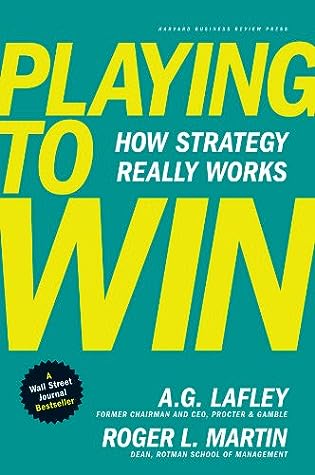More on this book
Community
Kindle Notes & Highlights
Optimization has a place in business, but it isn’t strategy.
They define strategy as following best practices. Every industry has tools and practices that become widespread and generic. Some organizations define strategy as benchmarking against competition and then doing the same set of activities but more effectively. Sameness isn’t strategy. It is a recipe for mediocrity.
But it is only through making and acting on choices that you can win. Yes, clear, tough choices force your hand and confine you to a path. But they also free you to focus on what matters.
a strategy is a coordinated and integrated set of five choices: a winning aspiration, where to play, how to win, core capabilities, and management systems.
What is your winning aspiration? The purpose of your enterprise, its motivating aspiration. Where will you play? A playing field where you can achieve that aspiration. How will you win? The way you will win on the chosen playing field. What capabilities must be in place? The set and configuration of capabilities required to win in the chosen way. What management systems are required? The systems and measures that enable the capabilities and support the choices.
An integrated cascade of choices
Aspirations are statements about the ideal future. At a later stage in the process, a company ties to those aspirations some specific benchmarks that measure progress toward them.
To determine how to win, an organization must decide what will enable it to create unique value and sustainably deliver that value to customers in a way that is distinct from the firm’s competitors. Michael Porter called it competitive advantage—the specific way a firm utilizes its advantages to create superior value for a consumer or a customer and in turn, superior returns for the firm.
The former descriptions are examples of marketing myopia, something economist Theodore Levitt identified a half-century ago and a danger that is alive and well today. Companies in the grips of marketing myopia are blinded by the products they make and are unable to see the larger purpose or true market dynamics. These companies spend billions of dollars making their new generation of products just slightly better than their old generation of products. They use entirely internal measures of progress and success—patents, technical achievements, and the like—without stepping back to consider the
...more
strategy is a coordinated and integrated set of where-to-play, how-to-win, core capability, and management system choices that uniquely meet a consumer’s needs, thereby creating competitive advantage and superior value for a business. Strategy is a way to win—and nothing less.
thinking about where to play. The first is to refuse to choose, attempting to play in every field all at once. The second is to attempt to buy your way out of an inherited and unattractive choice. The third is to accept a current choice as inevitable or unchangeable. Giving in to any one of these temptations leads to weak strategic choices and, often, to failure.
Have you defined winning, and are you crystal clear about your winning aspiration? Have you decided where you can play to win (and just as decisively where you will not play)? Have you determined how, specifically, you will win where you choose to play? Have you pinpointed and built your core capabilities in such a way that they enable your where-to-play and how-to-win choices? Do your management systems and key measures support your other four strategic choices?


